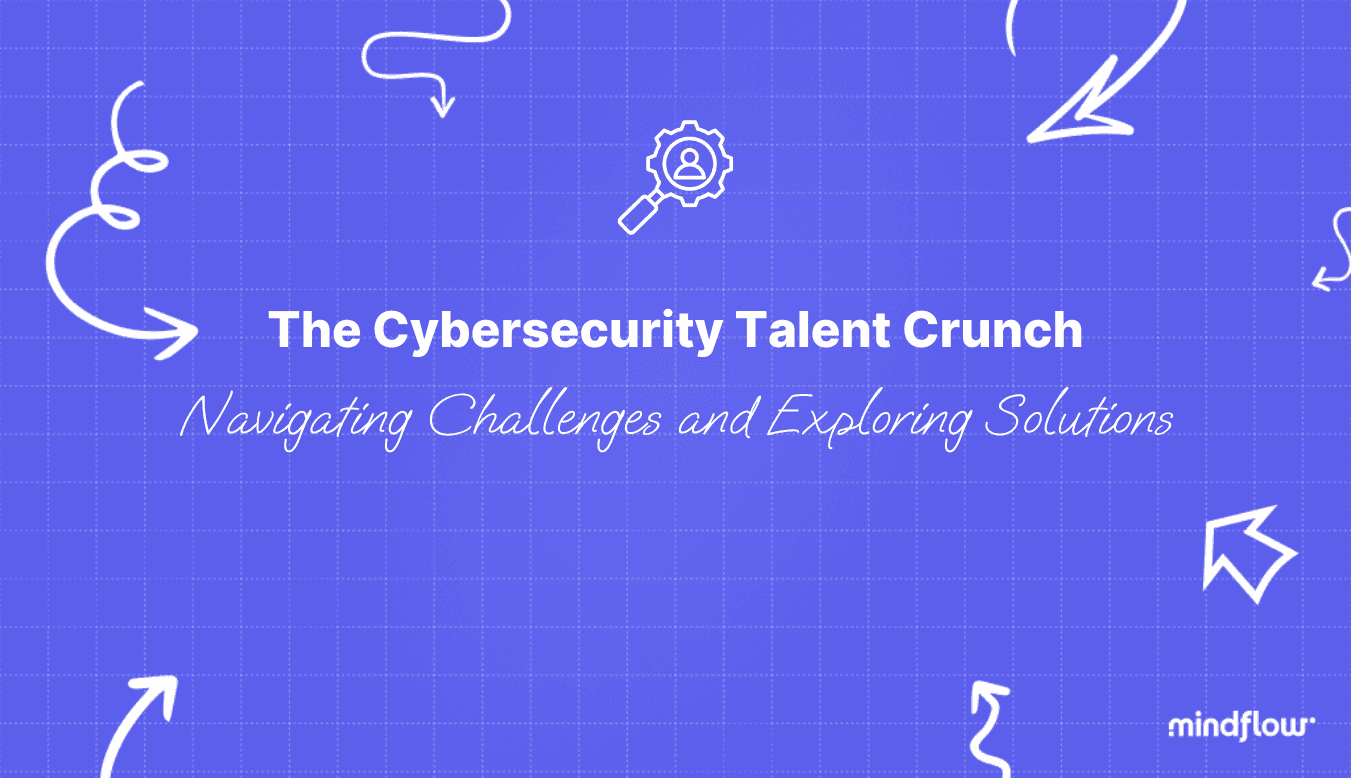Oct 3, 2024
Paul-Arthur
Jonville
Introduction
The cybersecurity landscape is facing a crisis of unprecedented proportions. As of today, there is a staggering gap of 3 million jobs that need to be filled. This article delves into the challenges faced by the cybersecurity industry, explores the reasons behind the talent crunch, and discusses potential solutions, including the role of innovative automation platforms like Mindflow.
The Growing Cybersecurity Threat Landscape
Increasing Cyber Attacks
Cyber attacks are increasing at an alarming rate. The FBI reported a 300% rise in cyber crimes in 2020 compared to 2019, with this trend continuing into subsequent years. Several factors drive this surge:
Expanding attack surfaces
The proliferation of IoT devices, expected to surpass 25 billion by 2030 from 10 billion in 2021, has significantly expanded potential vulnerabilities. Each new device extends the attack surface, presenting enterprises with substantial challenges securing the data flowing through these devices.
Remote work
The COVID-19 pandemic forced a rapid shift to remote work, often without adequate security measures. Staff members were compelled to work from home, sometimes without proper preparations or practices. This multiplied endpoints and increased breach risks for organizations.
Cloud adoption
As organizations move to the cloud to enhance agility and drive innovation, they face new security challenges. The workload on-premise is expected to drop to 38% in 2021, compared to 59% in 2019. By 2022, 90% of global enterprises will rely on hybrid cloud solutions. While this shift offers benefits like cost savings and increased agility, it also expands the attack surface and increases potential risks.
The Rising Costs of Cyber Attacks
The financial impact of cyber attacks is staggering. In 2020, a successful cyberattack cost small and medium businesses an average of $3.9 million. This trend is not purely contextual; cyber attacks continued to thrive in 2021 and beyond.
Several factors contribute to this alarming trend:
Low detection and prosecution rates are encouraging cybercriminals to act.
The absence of a specific legal framework in cyberspace creates an attractive cost/benefit balance for criminals from other countries.
The cost of launching cyber attack campaigns is decreasing. "Ransomware as a service" is now available on the dark web, allowing wannabe hackers to afford state-of-the-art tools.
By 2025, global cybercrime costs are projected to reach $10.5 trillion annually, up from $3 trillion in 2015. There is no other way around it: companies of all sizes and locations must strengthen their security measures.
The Cybersecurity Talent Shortage
The lack of qualified cybersecurity professionals is a global issue:
In 2021, 3.1 million cybersecurity agents were needed worldwide to protect information systems adequately. Although this number decreased from 4 million in the previous year, the gap remains wide and unlikely to be filled shortly.
64% of cybersecurity professionals reported at least a slight shortage in their staff.
Only about half of the industry professionals have computer and information science degrees. This doesn't necessarily mean they're unqualified, but it highlights the scarcity of traditionally trained experts.
This scarcity has led to increased competition for talent and higher salaries:
In the US, the average salary for a SOC analyst is 30% higher than the average US salary.
In France, it's 50% higher.
Ultimately, this creates a situation where only larger companies with better resources can fulfill their talent needs. Small and medium-sized companies, although equally at risk, are left behind with limited resources to face increasing attacks.
Challenges Faced by Cybersecurity Teams
Stress and burnout
Understaffed and overworked teams face constant pressure to protect their organizations with limited resources. They need more budget, hands, and eyes to monitor an ever-growing attack surface. As the last line of defense, they bear the ultimate cost of a breach.
Alert fatigue
Security teams are overwhelmed by the volume of threat alerts, with some facing tens of thousands to millions of alerts daily. On average, 50% of alerts go unanswered. Without appropriate tools, analysts dedicate excessive time to repetitive tasks with little added value, increasing the risk of mistakes.
Resource constraints
Cybersecurity professionals devote substantial time to separating false incidents from real ones. The next day brings the same challenges, with teams remaining understaffed while facing more attacks.
High stakes
Considering the potential risks of a breach (approximately $3 million for SMBs), the pressure on security teams is immense.
As a result, more than half of security teams feel overwhelmed by the volume of threat alerts and associated risks. This situation is unsustainable and requires immediate attention and solutions.
Potential Solutions to the Cybersecurity Talent Shortage
Changing recruitment strategies
Organizations should focus on hiring potential rather than only seeking fully qualified candidates. More than 51% of cybersecurity professionals transitioned into the field from other professions, such as mathematics, business, or finance. Companies should hire candidates who are willing to learn and train them to become security experts.
Education and training initiatives
Companies can implement programs to train employees from other fields in cybersecurity skills. Some organizations, like IBM, with its New Collar program, hire people with little cybersecurity experience and train them on the job.
Certification support
Many organizations (about 40%) are contributing to certification-related costs for their employees. However, it's worth noting that certifications like CISSP can take up to 4 years to validate.
Diversity in cybersecurity
Encouraging more women and minorities to enter the field could help address the talent shortage. The cybersecurity field is still perceived as male-dominated, but increasing diversity could tap into a formidable reservoir of potential talent.
Proper planning
Companies need to plan their cybersecurity architecture and training programs carefully. CISOs must determine staffing needs, establish training programs, and allocate resources for employee development.
The Role of Automation in Addressing Cybersecurity Challenges
Automation is becoming crucial in managing the growing volume of threats and alleviating the burden on cybersecurity teams:
It helps identify and prioritize threats correctly, reducing false positives and avoiding mismatched threat levels.
Automated responses to detected threats free up time for analysts to focus on more complex issues.
Managing known threats automatically allows more time to hunt for unknown ones, potentially reducing the Mean Time to Detect (MTTD) breaches, which currently take up to 6 months for most companies.
According to a SANS Institute report, half of SOC teams cite ineffective orchestration and automation as barriers to excellence. By implementing automation, organizations can do more with fewer human resources, ease the lives of their cybersecurity professionals, and empower their creativity.
Mindflow: An Innovative Approach to Cybersecurity Automation
Mindflow offers a state-of-the-art solution to many of the challenges discussed:
AI-driven automation: Mindflow's platform can handle routine tasks, freeing up human analysts for more complex problem-solving.
No-code capabilities: This feature allows teams to create and modify workflows without advanced programming skills, addressing the skill gap issue.
Extensive integration: Mindflow connects with thousands of vendors across various categories, enhancing the efficiency of existing security stacks.
Advanced analytics: The platform provides insights into playbook performance, helping teams optimize their processes.
Conclusion: Adapting to the Future of Cybersecurity
Organizations are facing and will continue to face growing threats. They must understand that cyberspace is becoming, or already is, a hostile environment by nature, and their security architecture must adapt to this reality. To address these challenges, companies need to:
Change their mindset about recruitment, widening the scope to look for potential candidates to train in addition to qualified workers.
Implement automation to alleviate the burden on cybersecurity teams, allowing them to handle known threats more efficiently.
Enable their teams to focus on more complex and rewarding tasks, empowering their creativity and job satisfaction.
By combining human expertise with AI-driven tools like Mindflow, companies can better protect themselves against the growing threat landscape, even in the face of talent shortages. The future of cybersecurity lies in empowering existing teams, bridging skill gaps, and enhancing threat detection and response through innovative technologies and strategies.








